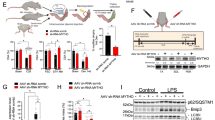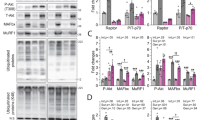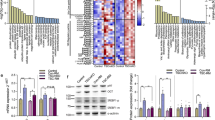Abstract
The mammalian target of rapamycin (mTOR) and Akt proteins regulate various steps of muscle development and growth, but the physiological relevance and the downstream effectors are under investigation1,2,3,4,5,6. Here we show that S6 kinase 1 (S6K1), a protein kinase activated by nutrients and insulin-like growth factors (IGFs), is essential for the control of muscle cytoplasmic volume by Akt and mTOR. Deletion of S6K1 does not affect myoblast cell proliferation but reduces myoblast size to the same extent as that observed with mTOR inhibition by rapamycin. In the differentiated state, S6K1−/− myotubes have a normal number of nuclei but are smaller, and their hypertrophic response to IGF1, nutrients and membrane-targeted Akt is blunted. These growth defects reveal that mTOR requires distinct effectors for the control of muscle cell cycle and size, potentially opening new avenues of therapeutic intervention against neoplasia or muscle atrophy.
This is a preview of subscription content, access via your institution
Access options
Subscribe to this journal
Receive 12 print issues and online access
$209.00 per year
only $17.42 per issue
Buy this article
- Purchase on Springer Link
- Instant access to full article PDF
Prices may be subject to local taxes which are calculated during checkout





Similar content being viewed by others
References
Rommel, C. et al. Mediation of IGF-1-induced skeletal myotube hypertrophy by PI(3)K/Akt/mTOR and PI(3)K/Akt/GSK3 pathways. Nature Cell Biol. 3, 1009–1013 (2001).
Bodine, S.C. et al. Akt/mTOR pathway is a crucial regulator of skeletal muscle hypertrophy and can prevent muscle atrophy in vivo. Nature Cell Biol. 3, 1014–1019 (2001).
Pallafacchina, G., Calabria, E., Serrano, A.L., Kalhovde, J.M. & Schiaffino, S. A protein kinase B-dependent and rapamycin-sensitive pathway controls skeletal muscle growth but not fiber type specification. Proc. Natl. Acad. Sci. USA 99, 9213–9218 (2002).
Erbay, E., Park, I.H., Nuzzi, P.D., Schoenherr, C.J. & Chen, J. IGF-II transcription in skeletal myogenesis is controlled by mTOR and nutrients. J. Cell Biol. 163, 931–936 (2003).
Sandri, M. et al. Foxo transcription factors induce the atrophy-related ubiquitin ligase atrogin-1 and cause skeletal muscle atrophy. Cell 117, 399–412 (2004).
Stitt, T.N. et al. The IGF-1/PI3K/Akt pathway prevents expression of muscle atrophy-induced ubiquitin ligases by inhibiting FOXO transcription factors. Mol. Cell 14, 395–403 (2004).
Glass, D.J. Molecular mechanisms modulating muscle mass. Trends Mol. Med. 9, 344–350 (2003).
Abraham, R.T. Identification of TOR signaling complexes: more TORC for the cell growth engine. Cell 111, 9–12 (2002).
Manning, B.D. & Cantley, L.C. Rheb fills a GAP between TSC and TOR. Trends Biochem. Sci. 28, 573–576 (2003).
Coolican, S.A., Samuel, D.S., Ewton, D.Z., McWade, F.J. & Florini, J.R. The mitogenic and myogenic actions of insulin-like growth factors utilize distinct signaling pathways. J. Biol. Chem. 272, 6653–6662 (1997).
Huang, S. et al. Sustained activation of the JNK cascade and rapamycin-induced apoptosis are suppressed by p53/p21(Cip1). Mol. Cell 11, 1491–1501 (2003).
Montagne, J. et al. Drosophila S6 kinase: a regulator of cell size. Science 285, 2126–2129 (1999).
Zhang, H., Stallock, J.P., Ng, J.C., Reinhard, C. & Neufeld, T.P. Regulation of cellular growth by the Drosophila target of rapamycin dTOR. Genes Dev. 14, 2712–2724 (2000).
Miron, M. et al. The translational inhibitor 4E-BP is an effector of PI(3)K/Akt signalling and cell growth in Drosophila. Nature Cell Biol. 3, 596–601 (2001).
Fingar, D.C., Salama, S., Tsou, C., Harlow, E. & Blenis, J. Mammalian cell size is controlled by mTOR and its downstream targets S6K1 and 4EBP1/eIF4E. Genes Dev. 16, 1472–1487 (2002).
Fingar, D.C. et al. mTOR controls cell cycle progression through its cell growth effectors S6K1 and 4E-BP1/eukaryotic translation initiation factor 4E. Mol. Cell. Biol. 24, 200–216 (2004).
Pende, M. et al. S6K1(−/−)/S6K2(−/−) Mice exhibit perinatal lethality and rapamycin-sensitive 5′-terminal oligopyrimidine mRNA translation and reveal a mitogen-activated protein kinase-dependent S6 kinase pathway. Mol. Cell. Biol. 24, 3112–3124 (2004).
Pende, M. et al. Hypoinsulinaemia, glucose intolerance and diminished beta-cell size in S6K1-deficient mice. Nature 408, 994–997 (2000).
Gingras, A.C. et al. Hierarchical phosphorylation of the translation inhibitor 4E-BP1. Genes Dev. 15, 2852–2864 (2001).
Whiteman, E.L., Cho, H. & Birnbaum, M.J. Role of Akt/protein kinase B in metabolism. Trends Endocrinol. Metab 13, 444–451 (2002).
Lorberg, A. & Hall, M.N. TOR: the first 10 years. Curr. Top. Microbiol. Immunol. 279, 1–18 (2004).
Conlon, I. & Raff, M. Differences in the way a mammalian cell and yeast cells coordinate cell growth and cell-cycle progression. J. Biol. 2, 7 (2003).
Dolznig, H., Grebien, F., Sauer, T., Beug, H. & Mullner, E.W. Evidence for a size-sensing mechanism in animal cells. Nature Cell Biol. 6, 899–905 (2004).
Shima, H. et al. Disruption of the p70(s6k)/p85(s6k) gene reveals a small mouse phenotype and a new functional S6 kinase. EMBO J. 17, 6649–6659 (1998).
Pinset, C. & Montarras, D. in Cell Biology, a Laboratory Handbook (ed. Celis, J.) 226–232 (Academic, New York, 1998).
Acknowledgements
We thank the Novartis Foundation and George Thomas laboratory for the use of S6K mutant mice. We thank J. McMullen, G. Pavlath, R. Scharfmann, G. Thomas and R. Treisman for reading the manuscript and for helpful discussions; the members of INSERM-U584 for support; Genethon (Evry) for adenovirus production; C. Cordier for expert technical assistance with the FACS analysis; M. Birnbaum for providing adenovirus expressing MyrAkt1 and kinase-inactive Akt1; and G. Thomas for providing adenovirus expressing RR-S6K1. M.P. has been a recipient of a stipend from the Fondation pour la recherche médicale, and A.S. from the INSERM and Conseil Regional d'Ile de France. This work was supported by a grant to M.P. from the INSERM Avenir programme (R01131KS) and from INSERM-Fondation pour la recherche médicale–Juvenile Diabetes Research Foundation International (4DA03H), and to A.S. and M.P. from the Association Française contre les Myopathies (9971) and from the ARC (7647).
Author information
Authors and Affiliations
Corresponding authors
Ethics declarations
Competing interests
The authors declare no competing financial interests.
Supplementary information
Supplementary Information
Supplementary figures S1, S2, S3 and S4 (PDF 170 kb)
Rights and permissions
About this article
Cite this article
Ohanna, M., Sobering, A., Lapointe, T. et al. Atrophy of S6K1−/− skeletal muscle cells reveals distinct mTOR effectors for cell cycle and size control. Nat Cell Biol 7, 286–294 (2005). https://doi.org/10.1038/ncb1231
Received:
Accepted:
Published:
Issue Date:
DOI: https://doi.org/10.1038/ncb1231
This article is cited by
-
Muscle 4EBP1 activation modifies the structure and function of the neuromuscular junction in mice
Nature Communications (2022)
-
Beyond controlling cell size: functional analyses of S6K in tumorigenesis
Cell Death & Disease (2022)
-
The Effects of Very Low Energy Diets and Low Energy Diets with Exercise Training on Skeletal Muscle Mass: A Narrative Review
Advances in Therapy (2021)
-
Defective endoplasmic reticulum-mitochondria contacts and bioenergetics in SEPN1-related myopathy
Cell Death & Differentiation (2021)
-
Eukaryotic translation initiation factors as promising targets in cancer therapy
Cell Communication and Signaling (2020)



